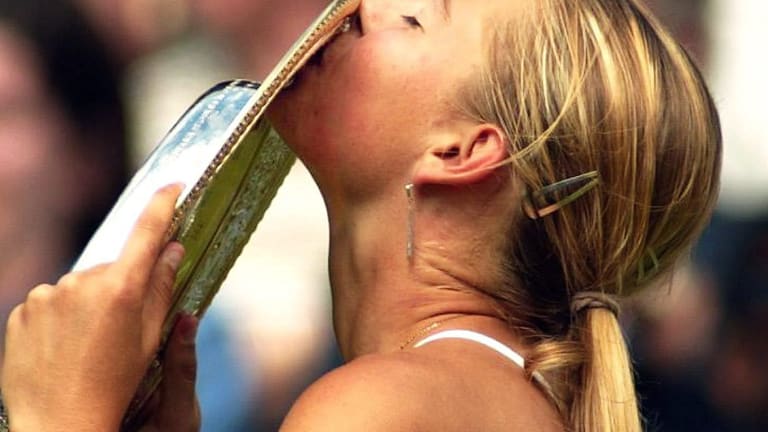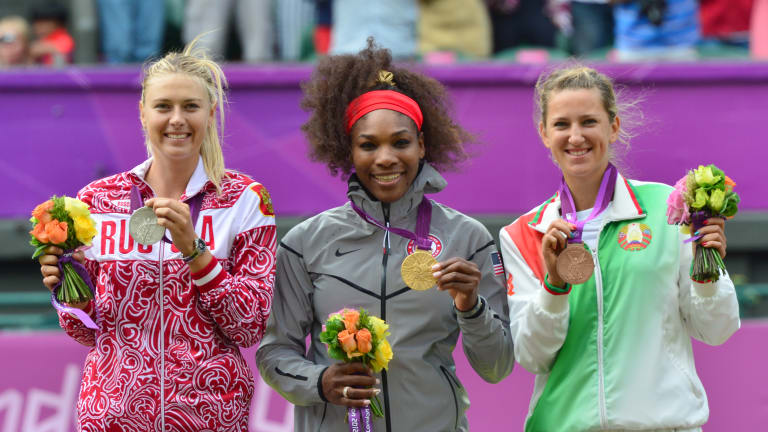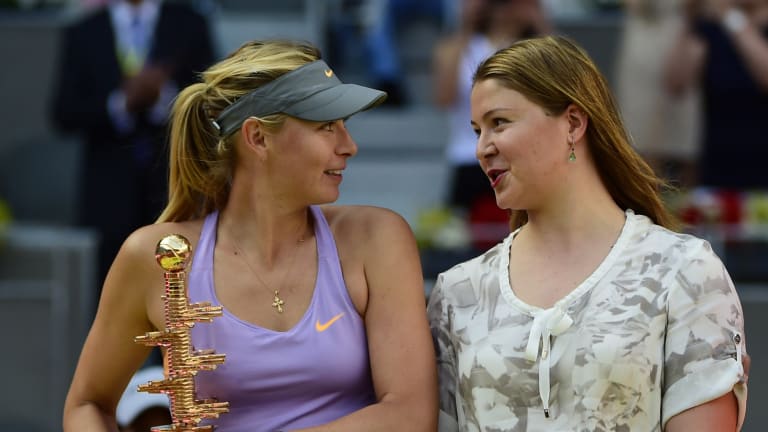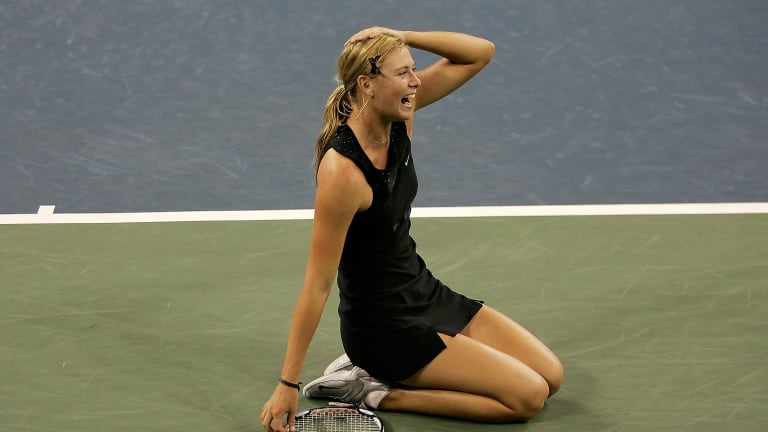From being one of six women in the Open era to complete a career Grand Slam to finishing 10 seasons inside the Top 10, a look back at some of the Russian’s achievements after the former No. 1 announced her retirement on Wednesday.
At 32, former world No. 1 Maria Sharapova announced her immediate retirement from professional tennis on Wednesday. Here are 32 things to know about the Russian’s standout career.
She’s a five-time Grand Slam champion. Sharapova won Wimbledon in 2004, the US Open in 2006, the Australian Open in 2008, the French Open in 2012 and the French Open again in 2014.
She’s one of only six women in the Open era to have won a Career Slam. The other five women to do it are Margaret Court, Chris Evert, Martina Navratilova, Steffi Graf and Serena Williams.
She’s the fourth-youngest Grand Slam champion in the Open era. She was 17 at Wimbledon in 2004. Only three players, all women, won their first major at a younger age, all at 16: Martina Hingis (1997 Australian Open), Monica Seles (1990 French Open) and Tracy Austin (1979 US Open).

By the Numbers: 32 things to know about Maria Sharapova’s career
© Bongarts/Getty Images
Getty Images
She’s the fifth-youngest No. 1 in WTA history. She was 18 years and 125 days when she first rose to the top spot on August 22, 2005. Only four women were younger: Graf (18 years and 64 days), Austin (17 years and 116 days), Seles (17 years and 99 days) and Hingis (16 years and 182 days).
She spent 21 career weeks at No. 1. Those 21 weeks came in five separate stints: August 22 to 28, 2005 (one week), September 12 to October 23, 2005 (six weeks), January 29 to March 18, 2007 (seven weeks), May 19 to June 8, 2008 (three weeks) and June 11 to July 8, 2012 (four weeks).
She won a total of 36 career WTA titles. She has the 15th-most career WTA titles in the Open era, and only three active players have more: Serena (73), Venus Williams (49) and Kim Clijsters (41).
Apart from her five majors, her biggest title came at the WTA Finals in 2004. Sharapova rallied from 4-0 down in the third set to beat Serena in the final of the season-ending event, 4-6, 6-2, 6-4.
She also won four Premier Mandatory titles. Her first two came seven years apart at Indian Wells, in 2006 and 2013, and she won two more in 2014 at Madrid and Beijing.
She won at least one WTA title for 13 years in a row from 2003 to 2015. Only three women have longer streaks: Navratilova (21 years in a row), Evert (18 years in a row) and Graf (14 years in a row).
She won a silver medal at the London Olympics in 2012. In her only career appearance at the Olympics, Sharapova made it to the gold medal match before falling to an on-fire Serena, 6-0, 6-1.

By the Numbers: 32 things to know about Maria Sharapova’s career
© AFP via Getty Images
Getty Images
She was 2-20 against Serena, but that was 2-1 at one point. After winning two of their first three meetings in 2004, Sharapova very nearly won their fourth meeting too, holding three match points in the 2005 Australian Open semifinals before losing, 2-6, 7-5, 8-6. The rest is history.
She had winning records against many of her other contemporaries, though. She was 5-3 against Venus, 8-7 against Victoria Azarenka, 7-4 against Caroline Wozniacki, 7-2 against Simona Halep, 5-1 against Lindsay Davenport and 2-1 against Hingis, just to name a few of her rivals.
She reached the quarterfinals or better at 25 of the 58 majors she played. In addition to her five titles, she also reached another five finals, another 10 semifinals and another five quarterfinals. Her 25th and final major quarterfinal came at the 2018 French Open, falling to Garbine Muguruza.
She won almost 80% of the matches she played. Sharapova finishes with a career win-loss record of 604-166 in tour-level matches (.784) and 645-171 across all levels (.790).
She had a winning record against Top 20 AND Top 10 players. She was 172-106 against Top 20 players (.619) and 98-69 against Top 10 players (.587). She was 43-43 against Top 5 players (.500).
She earned $38,777,962 in career prize money. That puts her in third place all-time in women’s tennis after Serena and Venus, who are currently at $92,715,122 and $41,801,056, respectively.
She’s one of only 12 women in the Open era to win five (or more) Grand Slam singles titles. The other 11 women to capture at least five are Serena (23), Graf (22), Evert (18), Navratilova (18), Court (11), Seles (9), Billie Jean King (8), Evonne Goolagong (7), Justine Henin (7), Venus (7) and Hingis (5).
She was the second Russian woman to win a Grand Slam title. The first one beat her by just four weeks, as Anastasia Myskina became the first woman from her country to win a major at the 2004 French Open.
She was the first Russian woman to become No. 1. Dinara Safina is the only other Russian woman to reach the top spot. Two Russian men have reached No. 1: Yevgeny Kafelnikov and Marat Safin.

By the Numbers: 32 things to know about Maria Sharapova’s career
© AFP via Getty Images
Getty Images
She finished 10 years in the Top 10 (and nine years in the Top 5). She never finished a year at No. 1, but she came so close, finishing three years at No. 2 (2006, 2012 and 2014), five years at No. 4 (2004, 2005, 2011, 2013 and 2015), one year at No. 5 (2007) and one year at No. 9 (2008).
She won her first 23 night matches in a row at the US Open. The 2006 US Open champion was 23-0 in night matches in Flushing Meadows at one point, but she finishes her career 23-2, losing her last two to Carla Suarez Navarro in the fourth round in 2018 and to Serena in the first round in 2019.
She was a three-time champion at Stuttgart and Rome. Sharapova’s most successful WTA events in terms of titles won were Premier-level clay court events in Stuttgart and Rome, winning them each three times. She was also a two-time champion at seven more events.
She reached two Grand Slam finals as a junior, but lost them both. She was the girls’ runner-up at the 2002 Australian Open (to Barbora Strycova) and at 2002 Wimbledon (to Vera Dushevina).
She was voted WTA Most Improved Player AND WTA Player Of The Year in 2004. She’s one of only two players ever to win both of those awards in the same year (Petra Kvitova received both in 2011). Sharapova was also voted the WTA’s Most Impressive Newcomer the year before.
She won three WTA doubles titles. She got them in her first few years on the tour, at Tokyo and Luxembourg in 2003 with Tamarine Tanasugarn and at Birmingham in 2004 with Maria Kirilenko.
She played Fed Cup for Russia in 2008, 2011, 2012 and 2015. She played one Fed Cup Final in 2015, scoring both of Russia’s points in the tie with singles wins over Karolina Pliskova and Kvitova, before the Czech Republic clinched a 3-2 victory with a win in the deciding doubles rubber.
She had seven career wins over No. 1s. Her first win over a No. 1 came against Davenport at Tokyo in 2005; her last win over a No. 1 came against Azarenka at the WTA Finals in 2012.
She beat No. 1 and No. 2 at the 2006 US Open, something that’s only happened once at a major since then. Sharapova beat No. 1 Amelie Mauresmo in the semifinals and No. 2 Henin in the final en route to her US Open title in 2006. Since then, only one woman has beaten the Top 2 players in the world at a major–Svetlana Kuznetsova did it at the 2009 French Open (and won the title too).

By the Numbers: 32 things to know about Maria Sharapova’s career
Getty Images
Her career was littered with lay-offs. Apart from her 15-month banned substance suspension from January 2016 to April 2017, Sharapova missed a slew of Grand Slams over the course of her career due to injury. She even had two shoulder surgeries, one in October 2008 and one in February 2019.
At one point, she’d won 51 of 53 first-round matches at majors. She finished her career 51-7, but in the 16 years between the summers of 2003 and 2019 she was 51-2, her only first-round losses at majors coming to Kirilenko at the 2010 Australian Open and Vitalia Diatchenko at 2018 Wimbledon.
She played her first WTA event at Indian Wells in 2002. As an unranked 14-year-old wildcard, she beat No. 302 Brie Rippner in the first round before falling to No. 9 Monica Seles, her idol, 6-0, 6-2.
She played her final event at the 2020 Australian Open. As a No. 145-ranked wild card, she lost to No. 20 Donna Vekic in the first round, 6-3, 6-4. “It definitely didn’t feel like playing a wildcard,” Vekic said afterwards. “Maria is a great player, a champion. I practiced with her in the off-season, and it was my first practice set, actually, and she had been practicing for a while. She killed me, like, 6-1.”

